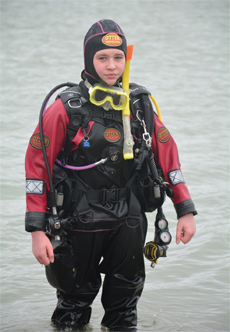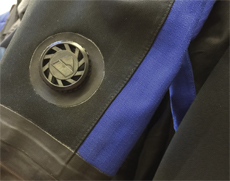




| Home | Features | Club Nights | Underwater Pics | Feedback | Non-Celebrity Diver | Events | 8 August 2025 |
| Blog | Archive | Medical FAQs | Competitions | Travel Offers | The Crew | Contact Us | MDC | LDC |

|

|
 
 |
    ISSUE 21 ARCHIVE - DRY SUIT REVIEWCharlotte BurnsHi, I'm Charlotte Burns, aged 13yrs, a qualified PADI Junior Master Scuba Diver and BSAC Sports Diver. I have completed quite a few dive courses, one of which was a drysuit course, I would like to share my own personal experiences of what happened on my drysuit course and, as a young, growing diver like me, I also want to explain the differences to help you make the right choice. It's all individual so you can choose what suits your needs. I have dived in many different climates with my drysuit and just recently bought a new one as I had grown out of my first one, I will explain my choice and reasons a little later on.Why do people use drysuits?A drysuit keeps you dry – it's in the name - and gives a far bigger season for diving. In a wet suit you would dive perhaps from the end of April to October, but dry suits allow you to dive all year round. You are sealed in the suit with a layer of air that goes in and out using valves, this means you can be kept warm as your body heat warms the air and layers inside. Whilst in a drysuit you should wear warm clothing underneath to keep you warm. Undersuits are useful in cold climates. A drysuit is your best friend whilst diving in Britain, but before you meet your new best friend you must master how to use a drysuit in open water, and how to maintain your buoyancy, which you will learn on the drysuit course. Types of DrysuitsTwo of the main types are Tri-laminate and Neoprene, which can be warmer. You can get drysuits with latex or neoprene wrist and neck seals, some people find latex seals are better at stopping water leaking in. Neoprene drysuits keep you warmer but need more weight as they are more buoyant Tri-laminate is a thinner material, which allows more heat to escape; you can get telescopic drysuits which means it can grow with you and save you money. You can get fitted boots on the drysuit, or fitted Neoprene socks which you use with rock boots. There are rear entry and front entry suits; a rear entry suit needs someone to zip you up whereas a front entry suit is good if you must be self-sufficient. You can get away with having a slightly larger drysuit by bulking it out with layers but you may get some movement of air, though it gives more flexibility when bending down to pick up your weight belt or regs with ease. ValvesValves allow air to vent out of your suit; there are different valves that you can have fitted to control the air in the suit. You have an inflation valve on your chest and a release valve which can be put in different places, either on your shoulder or on your cuff. When you complete your course you will find which suits you best. A shoulder dump is variable when you come to a certain depth the suit will vent itself, a cuff dump gives you more control and can vent when you want. UndersuitsLook at getting different layers of undersuits, a base layer which could be fleece or cycling type base layer, then get the onesie or a two piece set which covers the kidneys and midriff which keeps you warmer around those areas and grows with you unlike a onesie. AccessoriesAccessories can make the suit personal and better for your needs. For example, pockets, and covers for zips. You can get neoprene and latex neck seals which are warmer and harder wearing, however if you break a latex Drysuit course seal its the end of your dive, if you rip a neoprene seal you can use neoprene glue to patch it up. Drysuit courseOn your drysuit course you will have to pre-read a course manual before your actual course. You start with pool dives and then embark on your open water dives. When in the pool you will do exercises to help maintain your buoyancy whilst wearing the drysuit, these exercises are like those on your open water course including fin pivots and hovers. Importance is placed on the movement of air in the suit and controlling your buoyancy. I remember finding the oddity of coming out for the water bone-dry from the neck down amazing. The course takes 2 days minimum and is useful for the rest of your life. What do they Cost?There are many different brands; though a good wetsuit can cost around £250, a basic dry suit will start at around 21 £499 and can go up to over £1,000 for a more hard wearing one, like a kevlar coated drysuit that commercial divers use. When you have grown out of your drysuit you can sell it as people are always looking for them. You will be surprised that a made to measure drysuit is not much more expensive, a bit of extra money for comfort is recommended. My Choice and WhyI started with a Tri-laminate Typhoon drysuit and used a Weasle make undersuit, I have dived on the west coast of Scotland at below zero degrees, it was great. Thanks to Nigel at Typhoon who helped with my drysuit as I grew, by adjusting it until it couldn't be adjusted any more, you've helped a lot! I have also been taught loads about drysuits by Matt at Andark's shop in Southampton who I interviewed for extra information for this article. At the dive show in Birmingham John at Otter drysuits showed me the benefit of having a made to measure drysuit and recommended a telescopic Tri-laminate drysuit, I chose the colours, notice in the photo my pink stitching pocket and valve locations. I love this suit, my mum bought me it for my Christmas present, it's flexible, warm and will last me for ages. I chose neoprene socks on the suit so if my feet grow I just need to get bigger rock boots. |